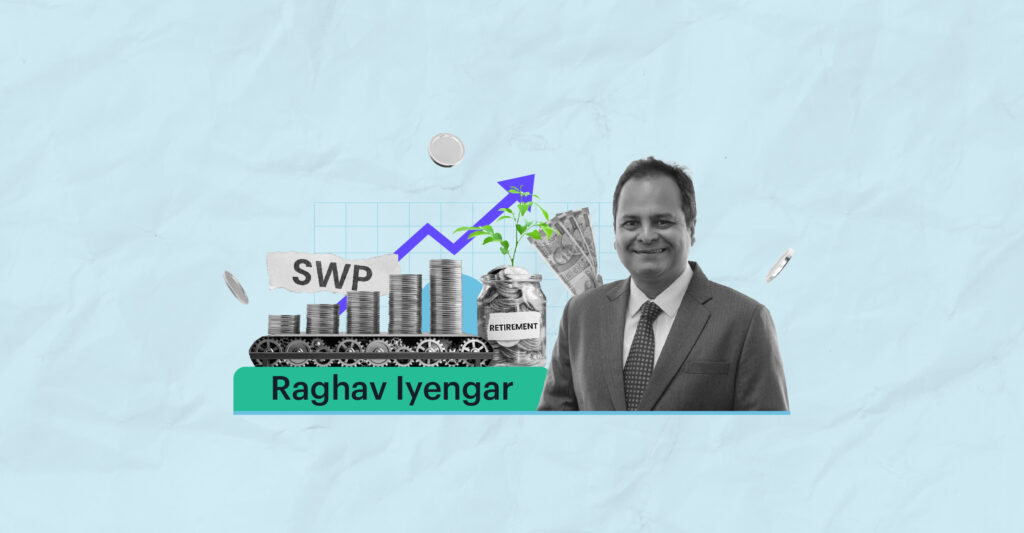Last Updated on Oct 20, 2022 by
While everyone wants to be financially free in their life, one needs to create a proper cash flow that covers up their day-to-day and unforeseen expenses. To lead a peaceful retired life and maintain the current standard of living without any major change, one needs to start investing actively as early as possible. Just like the Systematic Investment Plan (SIP), where investors invest a specific amount on a monthly basis to build wealth, SWP (Systematic Withdrawal Plan) allows investors to withdraw a specific amount from their investment on a monthly/quarterly basis.
SWP, as the name suggests, enables an investor to withdraw the desired amount at regular intervals from the money invested in their mutual fund portfolio. While an investor may withdraw a specified amount from the fund, the remaining units in the scheme continue to grow over time. Thus, SWP provides a regular cash flow and creates a disciplined spending approach.
Table of Contents
Benefits of investing in SWP
The flexibility of withdrawal
There are various ways in which an investor can customise their SWP to suit their spending needs. An investor can choose regular intervals (monthly, quarterly, half-yearly, or annually) at which they would want the cash flow. They can have the flexibility of choosing the date, frequency, amount etc., depending on the invested money and estimated expenses. SWP can be activated for as long as there are balance units in the scheme or till the end of the tenure.
An investor can also stop the SWP at any point or even increase/decrease the amount of withdrawal. They can also add fresh investment to the scheme whenever possible to increase the corpus and go on with the withdrawal for a little longer.
Rupee-cost averaging
SWP aims to provide the benefit of rupee-cost averaging as the units are not redeemed in one go. By way of regular redemption of mutual fund units via SWP, the investor need not time the market. When the markets are adverse, more units will be redeemed; however, when the markets are favourable, an investor might get more even by redeeming fewer units. While the withdrawals are happening, the remaining amount stays invested in the market and grows accordingly.
Benefit from the power of compounding
As an investor withdraws only a portion of the investment, the remaining amount continues to benefit from the power of compounding. Money invested in the market over a long term earns returns on the principal amount, and the accumulated interest amount grows over successive periods. This helps an investor beat inflation returns and volatility in the long run.
The habit of discipline in investments
SWP automatically withdraws a fixed amount periodically to meet the investor’s regular expenses, avoiding the investor’s urge to time the market. It tries to protect investors from withdrawing large amounts due to panic or fear during the falling market. On the other hand, it proves to be beneficial for the investor in the growing market by withdrawing the said amount, thereby taking advantage of the rise in the return of investment.
SWP works effectively when:
- The investment corpus is relatively higher to meet the goal of creating a regular stream of cash flow
- A withdrawal plan is started at least after one year of the initial investment to avoid short-term capital gain tax and a higher possibility of a considerable corpus
- SWP is properly planned to keep the goal in mind to avoid the corpus from getting withdrawn before the target date.
Taxation on SWP
Withdrawal of mutual funds attracts some taxation. One must also understand the impact of tax before choosing an investment.
In case of withdrawal of equity funds, a short-term capital gain tax of 15% is levied if withdrawn before one year. Also, an exit load is levied, depending on the fund house will be charged on purchases that are redeemed within one year. After 1 yr, a long-term capital gain tax of 10% is levied in excess of one lakh of gains, without the indexation benefit.
In a debt fund, a short-term capital gain tax is levied at the slab rate when redeemed before 3 yrs. And 20% with an indexation benefit is added after 3 yrs, which is a long-term capital gain tax (assuming the investor is resident in India). Above mentioned tax rates shall be increased by applicable surcharge and health and education cess.
Whichever scheme an investor invests in, whether Equity, Debt Hybrid etc., depending on the risk profile, they can opt for SWP. Just like SIP creates a disciplined investment approach, SWP creates a disciplined withdrawal approach in the investment journey of an investor. In a way, investors can create their pension plans by systematically planning their investments. However, to have an effective SWP in place, take proper advice from a financial expert.
Disclaimer: This press release represents the views of Axis Asset Management Co. Ltd. and must not be taken as the basis for an investment decision. Neither Axis Mutual Fund, Axis Mutual Fund Trustee Limited nor Axis Asset Management Company Limited, its Directors or associates shall be liable for any damages including lost revenue or lost profits that may arise from the use of the information contained herein. Investors are requested to consult their financial, tax and other advisors before taking any investment decision(s). Statutory Details: Axis Mutual Fund has been established as a Trust under the Indian Trusts Act, 1882, sponsored by Axis Bank Ltd. (liability restricted to Rs. 1 Lakh). Trustee: Axis Mutual Fund Trustee Ltd. Investment Manager: Axis Asset Management Co. Ltd. (the AMC). Risk Factors: Axis Bank Limited is not liable or responsible for any loss or shortfall resulting from the operation of the scheme. No representation or warranty is made as to the accuracy, completeness or fairness of the information and opinions contained herein. The AMC reserves the right to make modifications and alterations to this statement as may be required from time to time.
The information set out above is included for general information purposes only and does not constitute legal or tax advice. In view of the individual nature of the tax consequences, each investor is advised to consult his or her own tax consultant with respect to specific tax implications arising out of their participation in the Scheme. Income Tax benefits to the mutual fund & to the unit holder is in accordance with the prevailing tax laws as certified by the mutual funds consultant. Any action taken by you on the basis of the information contained herein is your responsibility alone. Axis Mutual Fund will not be liable in any manner for the consequences of such action taken by you. The information contained herein is not intended as an offer or solicitation for the purchase and sales of any schemes of Axis Mutual Fund.
Past performance may or may not be sustained in the future.
Stock(s) / Issuer(s)/ Sectors mentioned above are for illustration purpose and should not be construed as recommendation.
- The Extraordinary Affinity Between Colours and Investment Strategies! - Mar 9, 2023
- 7 Ways To Conduct Your Wealth Check-Up for 2023 - Jan 6, 2023
- Five Ways To Build Wealth in the Long Term - Oct 27, 2022





